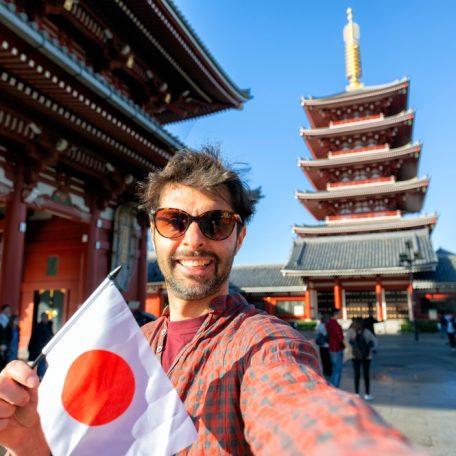Taste of Hibiya: A Pocket of Japanese Culture and History
Apr 24, 2024
BY Clarence Rowan

While not an “official” Tokyo neighborhood, the Hibiya area is known as a business and theater district and is considered as one of the most important neighborhoods of Japan’s capital city. Part of the Chiyoda Ward, the heart of Tokyo, Hibiya refers to a small area that covers Hibiya Park and a part of Yurakucho. During the period of the Tokugawa shogunate, the area of Hibiya transitioned from a fishing village to an urban area that served as a residential area for the Daimyo, or Japanese feudal lords.

Imperial Palace East Gardens | Photo Credit: Geoff Whalan (Flickr)
Imperial Palace East Gardens
The Imperial Palace, the official residence of Japan’s imperial family, is located in Hibiya. Whilst the palace itself is not open to the public except during New Year and the Emperor’s Birthday, visitors can visit the adjacent Imperial Palace East Gardens instead. Open throughout the rest of the year, the gardens are part of the palace’s inner grounds and where the former Edo Castle once stood. Locals and tourists can enjoy the beautifully landscaped Japanese-style gardens and the preserved ruins of Edo Castle, including the foundation of what was once known as the country’s tallest castle tower.

Hibiya Park | Photo Credit: Wikimedia Commons
Hibiya Park
Also rich in history is the 16-acre Hibiya Park located near the Imperial Palace East Gardens. Known as Japan’s first Western-style garden, the park originally served as feudal grounds and a military parade square during the Edo period and Meiji era. Home to a variety of seasonal trees and flowers, visitors are able to enjoy the park any month of the year. The park is especially famous for its avenue of ginkgo trees, including a 500-year-old tree called “kubi-kake ginkgo”.
The park is also a popular venue for concerts and cultural festivals like Oktoberfest and Christmas markets.

Imperial Theater | Photo Credit: Wikimedia Commons
Imperial Theater
If Hibiya Park is Japan’s first Western-style garden, then the Imperial Theater, or Teikoku Gekijo (帝国劇場), also located in the Hibiya area is the country’s first Western-style theater. The theater has had a significant role in shaping the country’s cultural landscape since its opening in 1911. The building’s design takes inspiration from the Renaissance style while featuring several artworks in its lobby by Japanese artists. Most importantly, the Imperial Theater has hosted different productions like Miss Saigon, The Man of La Mancha, and Les Misérables.

Takarazuka Revue | Photo Credit: Takarazuka Revue Official Website
Takarazuka Theater
For those on the lookout for unique theater experiences, Takarazuka Theater should not be missed out on! The theater is the Tokyo home to the famous theater company Takarazuka Revue, founded in 1913 in Hyogo, Japan. One of the company’s unique points is that Takarazuka Revue has only been made up of an all-female cast since its establishment, the complete opposite to kabuki that is known for only being performed by men.
The Takarazuka Theater is where you can witness the company’s elaborate choreographies accompanied by grandiose costumes as they perform classic Western musicals, operas, and even French cabarets!

Gado Shita Restaurants | Photo Credit: Visit Chiyoda
Gado Shita Restaurants
A quintessential feature of Tokyo is the small restaurants or stalls you see under the train tracks called gado shita restaurants, which literally means under the girder. The most well-known and the biggest area for these gado shita restaurants is in the Hibiya district, specifically under the Yamanote Line that runs from Yurakucho and Shimbashi. Countless yakitori joints, izakayas, Chinese restaurants, Korean restaurants, and more can be found here. The cheap prices yet quality food served made this area a popular hangout spot after work hours thus dubbing it as a “salaryman’s heaven”.

Hibiya Matsumotoro | Photo Credit: Visit Chiyoda
Hibiya Matsumotoro
On the fancier side, there is the Hibiya Matsumotoro located inside Hibiya Park. The restaurant opened its doors to the public the same year the park opened, which was in 1903. With a long history, it’s not surprising that the restaurant has had its fair share of famous regulars, including the Japanese novelist Natsume Soseki, and Chinese philosopher and physician, Sun Yat-Sen.
The restaurant’s beef curry and omelet rice comes highly recommended. However, if you find yourself wanting to try a little bit of everything, get their Matsumotoro Big Plate which consists of omelet rice and a choice of one main dish (hamburg steak, crab croquette, fried shrimp).

Nanzen-ji Hyotei Cuisine | Photo Credit: Tokyo Midtown Hibiya
Nanzen-ji Hyotei
Transport yourself to Japan’s old capital in the middle of Tokyo when you eat in Nanzen-ji Hyotei. Located in Midtown Hibiya, this restaurant specializes in Kyoto cuisine and actually has a 450-year long history ever since it was built near Nanzenji Temple. Led by the 15th generation owner and head chef, Yoshihiro Takahashi, you are sure to enjoy a very special (and traditional!) kaiseki dining experience in Nanzen-ji Hyotei.
While not as big as the more well-known neighborhoods of Tokyo, Hibiya has a lot to offer to anyone who decides to drop by the area. A place full of history among its buildings and parks, combined with a thriving culture of the arts, the Hibiya neighborhood is a must-visit on your next trip to Tokyo!
Featured image: Pierre Blaché (Pexels)
Looking for a culinary adventure during your next trip to Tokyo? Book your local guide now!
PIN THIS FOR LATER
Book your pocket wifi now to stay connected through your entire Japan Journey!

Be sure to get the JR Pass to make navigating Japan during your trip that much easier!

YOU MIGHT ALSO LIKE





